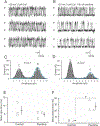MitoBKCa channel is functionally associated with its regulatory β1 subunit in cardiac mitochondria
- PMID: 31173379
- PMCID: PMC6690848
- DOI: 10.1113/JP277769
MitoBKCa channel is functionally associated with its regulatory β1 subunit in cardiac mitochondria
Abstract
Key points: Association of plasma membrane BKCa channels with BK-β subunits shapes their biophysical properties and physiological roles; however, functional modulation of the mitochondrial BKCa channel (mitoBKCa ) by BK-β subunits is not established. MitoBKCa -α and the regulatory BK-β1 subunit associate in mouse cardiac mitochondria. A large fraction of mitoBKCa display properties similar to that of plasma membrane BKCa when associated with BK-β1 (left-shifted voltage dependence of activation, V1/2 = -55 mV, 12 µm matrix Ca2+ ). In BK-β1 knockout mice, cardiac mitoBKCa displayed a low Po and a depolarized V1/2 of activation (+47 mV at 12 µm matrix Ca2+ ) Co-expression of BKCa with the BK-β1 subunit in HeLa cells doubled the density of BKCa in mitochondria. The present study supports the view that the cardiac mitoBKCa channel is functionally modulated by the BK-β1 subunit; proper targeting and activation of mitoBKCa shapes mitochondrial Ca2+ handling.
Abstract: Association of the plasma membrane BKCa channel with auxiliary BK-β1-4 subunits profoundly affects the regulatory mechanisms and physiological processes in which this channel participates. However, functional association of mitochondrial BK (mitoBKCa ) with regulatory subunits is unknown. We report that mitoBKCa functionally associates with its regulatory subunit BK-β1 in adult rodent cardiomyocytes. Cardiac mitoBKCa is a calcium- and voltage-activated channel that is sensitive to paxilline with a large conductance for K+ of 300 pS. Additionally, mitoBKCa displays a high open probability (Po ) and voltage half-activation (V1/2 = -55 mV, n = 7) resembling that of plasma membrane BKCa when associated with its regulatory BK-β1 subunit. Immunochemistry assays demonstrated an interaction between mitochondrial BKCa -α and its BK-β1 subunit. Mitochondria from the BK-β1 knockout (KO) mice showed sparse mitoBKCa currents (five patches with mitoBKCa activity out of 28 total patches from n = 5 different hearts), displaying a depolarized V1/2 of activation (+47 mV in 12 µm matrix Ca2+ ). The reduced activity of mitoBKCa was accompanied by a high expression of BKCa transcript in the BK-β1 KO, suggesting a lower abundance of mitoBKCa channels in this genotype. Accordingly, BK-β1subunit increased the localization of BKDEC (i.e. the splice variant of BKCa that specifically targets mitochondria) into mitochondria by two-fold. Importantly, both paxilline-treated and BK-β1 KO mitochondria displayed a more rapid Ca2+ overload, featuring an early opening of the mitochondrial transition pore. We provide strong evidence that mitoBKCa associates with its regulatory BK-β1 subunit in cardiac mitochondria, ensuring proper targeting and activation of the mitoBKCa channel that helps to maintain mitochondrial Ca2+ homeostasis.
Keywords: Paxilline; cardiomyocytes; mitochondria; mitochondrial calcium retention capacity; potassium channel.
© 2019 The Authors. The Journal of Physiology © 2019 The Physiological Society.
Conflict of interest statement
Competing interests
The authors declare no competing financial interests.
Figures








References
-
- Barrett JN, Barrett EF & Dribin LB. (1981). Calcium-dependent slow potassium conductance in rat skeletal myotubes In press 82. - PubMed
-
- Bautista L, Castro MJ, Lopez-Barneo J & Castellano A. (2009). Hypoxia inducible factor-2alpha stabilization and maxi-K+ channel beta1-subunit gene repression by hypoxia in cardiac myocytes: role in preconditioning. Circ Res 104, 1364–1372. - PubMed
Publication types
MeSH terms
Substances
Grants and funding
LinkOut - more resources
Full Text Sources
Research Materials
Miscellaneous

